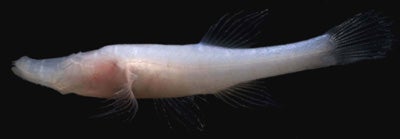ALABAMA CAVEFISH
picture © 2010 Danté Fenolio/www.anotheca.com
SCIENTIFIC NAME: Speoplatyrhinus poulsoni
CHARACTERISTICS: The Alabama cavefish is one of the rarest troglobitic fish species in North America. It is characterized by an extremely elongate, flattened head with a laterally constricted snout and a terminal mouth. It lacks pelvic fins, and fin rays are unbranched, with the fin membranes deeply incised between the rays. Speoplatyrhinus poulsoni has no eyes and practically no pigment. The elaborate system of sensory papillae, which are arranged in ridges on the head and sides, is apparently an adaptation to the dark environment these fishes inhabit. When this species was discovered in 1970, it was so unusual that a new genus had to be created for its description (Cooper and Kuehne, 1974).
ADULT SIZE: 1.2 to 2.3 in (30 to 58 mm)
DISTRIBUTION: Speoplatyrhinus poulsoniis known only from the type locality, Key Cave in Lauderdale County, Alabama.
HABITAT AND BIOLOGY: The type specimens of this species were netted near the surface of very clear, 10-foot-deep water below a bat roost (Cooper and Kuehne, 1974). Because the water contains nutrients supplied by bat guano, Key Cave supports an abundant and varied terrestrial invertebrate fauna, including mites, nematodes, dipterans, spiders, beetles, and millipedes. The troglobitic aquatic fauna is also diverse, consisting of two species of crayfishes, one species of amphipod, and one species of isopod. Cooper (1990) speculates that the Alabama cavefish, which is similar to the northern cavefish, Amblyopsis spelaea,uses its large mouth to incubate its eggs and protect its young. Population growth is speculated to be the lowest of all cave dwellers, and longevity is predicted to be between five and 10 years. Because its known range is limited to a single cave, the Alabama cavefish has an uncertain future, being threatened by changes in groundwater quality and level, changes in aquifer characteristics, diminished organic input, and perhaps competition with the syntopic southern cavefish, Typhlichthys subterraneus.
REMARKS: The Alabama cavefish is listed as endangered by the U.S. Fish and Wildlife Service.
ORIGINAL DESCRIPTION: Cooper and Kuehne described the Alabama cavefish in 1974.
ETYMOLOGY:
Speos means cave.
Platyrhinus means flat nose.
Poulsoni in honor of Thomas L. Poulson, for his work with amblyopsid fishes.
The copyrighted information above is from Fishes of Alabama and the Mobile Basin and www.anotheca.com. The Alabama Wildlife and Freshwater Fisheries Division protects the Alabama cavefish from capture or possession.






